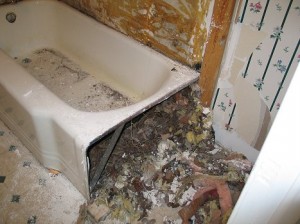 Here’s an easy pest control step you can take that should only take you about 10 minutes and could possibly save you thousands of dollars and keep any unwanted surpises from coming your way.
Here’s an easy pest control step you can take that should only take you about 10 minutes and could possibly save you thousands of dollars and keep any unwanted surpises from coming your way.
In the bug business we cut and install ‘bath traps’ all the time to give us access to plumbing pipes that subterranean termite’s use for entry as well as a whole host of other bugs. Actually it’s not unusual to find American roaches, spiders, Palmetto roaches, earwigs, Carpenter ants, you name it. The dark abyss is perfect for a lot of critters and the sweat on the plumbing pipe is all they need to sustain their moisture requirements.
The reasons to cut a trap;
As stated lots of bugs live in the void under your tub or at least enter there and then venture off through the walls looking for greener pastures. The contractor, in his infinite wisdom closes off this access in most homes that are on a slab. He also finds it necessary to leave a foot wide by foot long hole in the cement for a two inch pipe that protrudes up through the dirt. To make matters even worse, this ‘hole’ is formed up with wooden form boards and since he’s on a roll in the genius department he leaves the wood embedded in the ground, Hey might as well get the termites started off with a snack, right?
The back side of your tub and shower wall is where you’ll need to cut the vent in and that’s almost always in a closet but in our case it’s in a bedroom. This area is often overlooked but an access needs to be cut if you’re serious about protecting your home from termites and unwanted pests. Even if you open the wall and find nothing and your contractor actually closed up this hole with cement it will be worth doing because now you can rest assured that your plumbing area is correctly sealed and you probably will have avoided a lot of unseen damage.
How to cut a bath trap
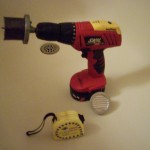 Let’s go with the easiest because as the title states, this should only take 10 minutes. You’ll need a drill, measuring tape; round drywall saw blade, and a dust pan. (Don’t want to leave a mess for your wife) The vent we’ll be putting in is a 2 inch round air vent or as we say, inspection vent. They use these vents also on soffits for attic ventilation and you can pick them up at Lowes or Home Depot for about $ 1.00.
Let’s go with the easiest because as the title states, this should only take 10 minutes. You’ll need a drill, measuring tape; round drywall saw blade, and a dust pan. (Don’t want to leave a mess for your wife) The vent we’ll be putting in is a 2 inch round air vent or as we say, inspection vent. They use these vents also on soffits for attic ventilation and you can pick them up at Lowes or Home Depot for about $ 1.00.
First measure the distance from the wall to the tub spout. This will tell you where the pipes are and  usually give you the center of the hole that the pipes come up from. Now, on the opposite side of the wall use your measure to see about where you will cut. In our case its 14 inches and that is typically the same for almost all tubs.
usually give you the center of the hole that the pipes come up from. Now, on the opposite side of the wall use your measure to see about where you will cut. In our case its 14 inches and that is typically the same for almost all tubs.
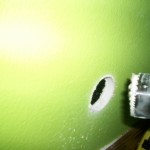 It’s important to remember that you are drilling near ‘soft pipes’ so don’t force anything; let the blade do the work. Also if you go to close to the floor you may hit the sill board so I usually go up about 4 to 6 inches. So, 14 inches in from the side wall and 4 or so inches up should put you right where you want to be. Now carefully drill the hole and watch the blade so you can see when you are through. When you’re done you have a perfect hole and the drywall stays neatly in the blade.
It’s important to remember that you are drilling near ‘soft pipes’ so don’t force anything; let the blade do the work. Also if you go to close to the floor you may hit the sill board so I usually go up about 4 to 6 inches. So, 14 inches in from the side wall and 4 or so inches up should put you right where you want to be. Now carefully drill the hole and watch the blade so you can see when you are through. When you’re done you have a perfect hole and the drywall stays neatly in the blade.
Take a look inside
It always amazes me when I open up a wall and see cobwebs, dead bugs and more times than not I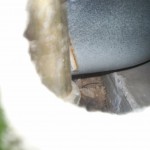 see termite shelter tubes. In our example there was very little to be seen but it did reveal the ‘dirt hole’ our friend the contractor left so in another post we’ll show you how to treat for termites in our trap. For now though if you have wood roaches, ants, earwigs or you can see roach droppings and the like this would be a great time to ‘dust’ this void which we learned about in an earlier article. You might even place a small toss pack of mouse bait in the void, this is one of the safest places to place the bait and mice may get into this void not by the dirt normally, but from the attic downward using the pipes to climb on.
see termite shelter tubes. In our example there was very little to be seen but it did reveal the ‘dirt hole’ our friend the contractor left so in another post we’ll show you how to treat for termites in our trap. For now though if you have wood roaches, ants, earwigs or you can see roach droppings and the like this would be a great time to ‘dust’ this void which we learned about in an earlier article. You might even place a small toss pack of mouse bait in the void, this is one of the safest places to place the bait and mice may get into this void not by the dirt normally, but from the attic downward using the pipes to climb on.
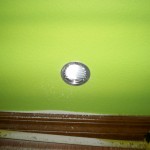 Now it’s a simple matter of placing your circular vent in the cut out, clean up a bit and you are done. The vent can come out and go back anytime so you can always do a quick retreat when needed. The vent also looks like it is part of the house, it blends in and any house guests will never know the pestcmetery you have hidden away.
Now it’s a simple matter of placing your circular vent in the cut out, clean up a bit and you are done. The vent can come out and go back anytime so you can always do a quick retreat when needed. The vent also looks like it is part of the house, it blends in and any house guests will never know the pestcmetery you have hidden away.





